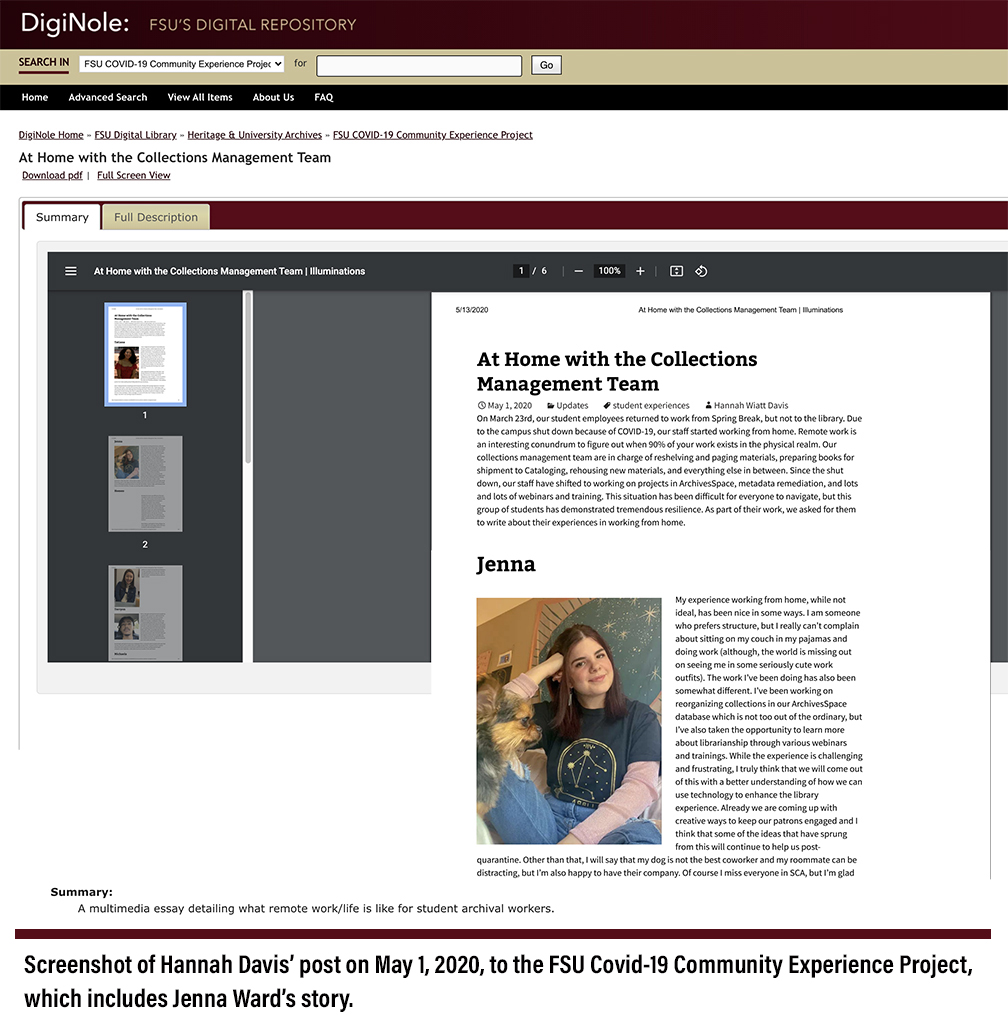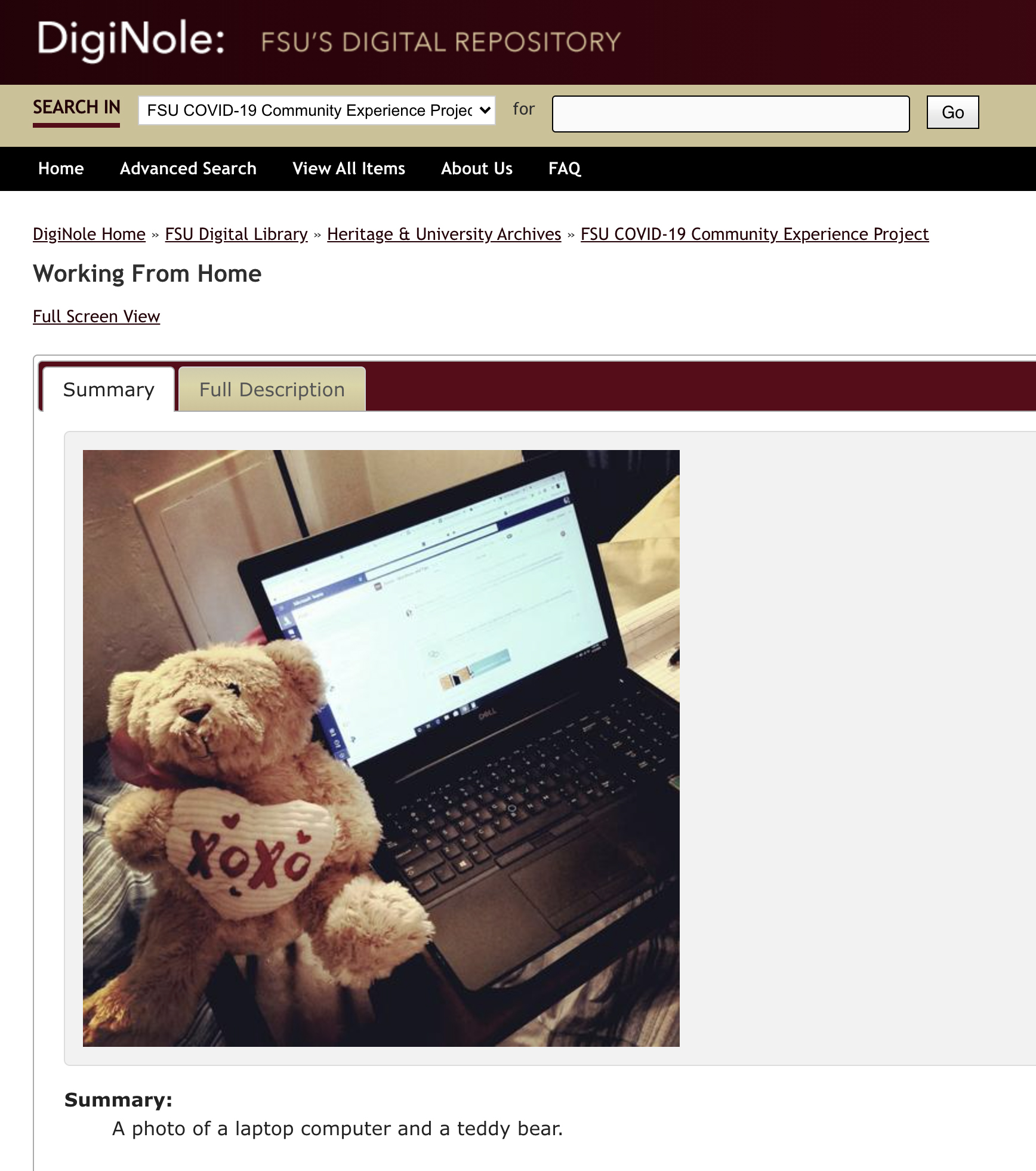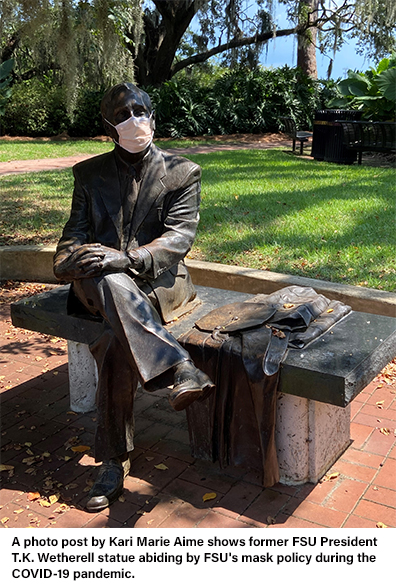FSU’s Digital Archive: preserving the historical fabric of the university during difficult times
By Sofia Cabrera
The fall semester at Florida State University began on Monday, Aug. 23, 2021—with a return to in-person classes and events. The university seemed to jump right in and resume normalcy after the removal of most pandemic restrictions.
Before this reopening, the majority of campus operations took place virtually for more than a year and a half. Six weeks into the semester, however, the FSU community has not forgotten about the Covid-19 pandemic’s impact.
When the countrywide and local shutdowns began in March 2020, University Archivist Sandra Varry, who also manages the Heritage & University Archives, and Digital Archivist Krystal Thomas met with several FSU professors about how the university could document this historic time. Varry’s and Thomas’ roles in Special Collections & Archives of the University Libraries involve capturing university history through outreach and collection and also encompass exhibition and projects.
“For us, it was important to record information about the pandemic due to the lack of documentation from previous pandemics,” Varry says.
When the pandemic restrictions began, Varry and the archivists began developing the Covid-19 Community Experience Project. According to project’s website, official records regarding the coronavirus and the university’s response were already being collected, in accordance with FSU’s Archives Policy. This particular project aimed to “include personal experiences and reactions to this challenging situation and include them as part of the archive.”
By April 2020, the archive was officially posted and available to the public through DigiNole, FSU's Digital Repository. FSU faculty, staff, and students were given the opportunity to contribute and post on the archive, and many have done so.
Tricia Rizza is a doctoral candidate in FSU’s Rhetoric and Composition Program, and since the fall of 2018 she has been co-administrator of the Museum of Everyday Writing (MoEW), a digital archive housed in the English department. She explains the benefits for people who collect and post records of their experiences in digital archives.
“Archiving artifacts in any context provides a great way to view experiences from a historical and more contextualized view,” she says.
Hannah Davis, preservation librarian in FSU Special Collections & Archives, oversees the collections management. She also monitors and works with various entities to keep the materials safe. Davis encouraged her own friends and classmates to participate in building the archive.
Davis’ involvement with SCA inspired her and others to use the archive as an outlet to voice their feelings and thoughts about the sudden change in their lives. Photos of their quarantine-restricted lives were also included.
“I am thrilled to see SCA’s staff members are part of the history we preserve,” Davis says, reflecting on her posts to the archive and those of others.
Archiving artifacts in any context provides a great way to view experiences from a historical and more contextualized view
— Tricia Rizza
Like Davis, Jenna Ward, a public services assistant for Special Collections & Archives at FSU, shared her own post to the archive. Specifically, she documented what it was like to work from home during the pandemic.
“Although our situation was challenging and frustrating, we were learning how to adjust for the future,” Ward says.
Ward also points out how the archive provides a timestamp of the pandemic.
“That blog post will always be in the archives to remind me of a time when life felt uncertain,” she states.
Rizza adds that online collections allow a wider audience to interact with others.
“The public’s interaction with the digital archive provides a recursive conversation regarding the dynamic and capaciousness of everyday writing,” Rizza says. She adds that the English department’s MoEW site provides a space for pedagogy, research, and public use.
Throughout the difficult past 18 months, the library staff involved says the archive has given Special Collections & Archives the opportunity to increase their collections, expand their network, and grow closer as a department. The digitization process provides access to documentation that previously did not exist.
expand their network, and grow closer as a department. The digitization process provides access to documentation that previously did not exist.
Varry hopes the Covid-19 Community Experience Project will give more depth to the pandemic’s history.
“We are providing this archive for the public and sharing it with others in order to create a full picture in an international way,” Varry says. Through time, however, she has noticed a decline in activity and involvement from the public.
“The pandemic was even more serious and intense [in the beginning],” she says. “By now, I would like to see more contributions; yet thinking about people’s situations makes it OK. Over time, we will do more outreach projects and have the archive opened indefinitely.”
Those who contributed to the creation of the archive encourage others to share their own pandemic experiences. The archive is not only preserved but also remains open to the public. The work is a complimentary project that falls on the historical fabric of FSU.
Q&A with Sandra Varry
What inspired you to accept your role in the creation of the archive?
Part of my job as the university’s archivist is to capture university history. Doing something like the digital archives is just an extension of my normal role for the university. My job not only deals with outreach, but I also see what is being collected. It is nice to be able to put together bits and pieces for other ideas, and there are about 20-30 university Covid-19 archives that are currently available.
When did you start gathering data and how do you see the data and contributions evolving over time?
We started gathering data in mid to late April of 2020. At first, there was a lot of interest from the public. However, as time went on, posting on the archive became slow. There was a shift in the world as the death toll started to rise. The pandemic was getting even more serious and very intense. For some, posting on the archive was cathartic. For others, it was not. Pandemic fatigue was another contributor for the slowness of the project. People were tired of being stuck in their homes for hours. [Future] projects will promote the archive, so I am interested to know what has happened during the pandemic and what has happened to not only us but the world after the fact.
What goals do you expect to accomplish with the creation of the archive?
For us, it was important to document the pandemic especially looking back on previous pandemics….I am also participating in other research studies. All these stories, whether international or national, are important, so we can put stories together from different perspectives.
How do you believe archive digitization has changed the way research is conducted?
Archive digitization allows access that previously did not exist. Before digitization, we had to visit a resource center and physically sit down with materials to conduct research. Not everything could be digitized. Today, there is faster research available for everyone. Digitization serves as two functions: it provides to the researcher and gives access to the public through the library.
How is the archive maintained and how can people interested in helping with that process become involved?
The preservation librarian plays a huge role with how the archive is maintained. All archivists learn basic preservation and management, and they have both physical and online access to the archive. The digital aspect of it has its own components that require maintenance. Archivists not only need to understand what needs to happen but also what should not happen.
 Regarding involvement, we offer volunteer and internship opportunities that allow for meaningful engagement. These opportunities are paid or unpaid. We have areas of expertise that depend on what the volunteer has to offer. Interning with us is a great way to get involved. The internship depends on what archive pertains to and interests the intern. Volunteers and interns can share research with us. Apparently, there is a myth that researchers find components hidden in the archive. It is for the researcher to go to the archive and interpret what they think they found and share it.
Regarding involvement, we offer volunteer and internship opportunities that allow for meaningful engagement. These opportunities are paid or unpaid. We have areas of expertise that depend on what the volunteer has to offer. Interning with us is a great way to get involved. The internship depends on what archive pertains to and interests the intern. Volunteers and interns can share research with us. Apparently, there is a myth that researchers find components hidden in the archive. It is for the researcher to go to the archive and interpret what they think they found and share it.
Q&A with Hannah Davis
Can you tell me a little bit about yourself and your role as a preservation librarian at FSU?
I have been the Preservation Librarian in FSU Special Collection & Archives (SCA) since 2018 and have worked in SCA in various roles since 2013. I am a double alumna of FSU, with a Bachelor of Arts in Music and MS in Library and Information Studies. In my role as Preservation Librarian, I oversee the preservation activities in SCA, which includes collections management, environmental monitoring, and working with various library entities to keep SCA materials safe in perpetuity.
What was the process for gathering information to that archive post?
When we first went remote, it was extremely stressful for our part-time staff, especially our student workers. Some folks were graduating that semester and were unsure if they would be able to walk in a ceremony. Others had to move back home, away from their friends and classmates, and they were living with distracting roommates. I really wanted them to have an outlet to voice their feelings about this sudden change in their lives, so I asked them if they would be interested in contributing to a blog post about what it was like to work from home. While the blog post centered on remote work in SCA, I encouraged them to get in their feelings (if they wanted to!). I also asked them to provide some photos of their quarantine-restricted lives.
How do you believe archive digitization has changed the way research is conducted?
Digitization of archival materials has certainly made research in Special Collections & Archives more accessible. Digitized collections that once could only be viewed in one reading room for limited hours are now available for anyone to research, anywhere at any time. The Digital Library Center, the department that digitizes SCA materials for the Digital Library, was indispensable during the pandemic. Because of their incredible work, SCA was able to keep up with research requests and instruction while our public spaces were closed.
What did this experience mean for you and for the students who posted in the document?
I was excited to be able to contribute to the Covid-19 Community Experience Project – it is cool that SCA’s staff members, and my experiences are part of the history that we preserve. When processing collections, I always think to myself how amazing it is that we can research and learn about the experiences of those who came before us; now, my own experience and those of our students will also be part of the historical fabric of FSU.
Q&A with Jenna Ward
Can you tell me a little bit about yourself and what you included in the digital archive?
I am a recent graduate from FSU College of Communication and Information, and the Public Services Assistant at FSU Special Collections and Archives. [Ward is currently a graduate student at the University of Tennessee-Knoxville.] My duties in this position range from creating graphics to posting on social media and the Illuminations blog. I even conduct inventory of new collections. In the digital archive, I shared what it was like to work from home when Covid-19 first came to the States in spring of 2020. One thing I pointed out was that although our situation was at times difficult and frustrating, there were things that we were learning how to adjust to that would help us in the future, and I think I was totally right! Pandemics suck, but it has given SCA the opportunity to digitize a lot of components and increase access to our collections, expand our network, and grow closer as a department as we encounter challenges together.
What did this experience mean for you as someone who posted in the archive?
I liked being able to post in the digital archive because I got to express what I was thinking at a point in time that was honestly stressful for me. It is cool to look back and see that timestamp because I had worries about the future, but I was hopeful. A little more than a year later, and most things turned out fine. Despite these achieves in a time of uncertainty, that blog post will always be in the archives to remind me when life felt uncertain.
Q&A with Tricia Rizza
How long have you been a part of the Museum of Everyday Writing?
I have had the opportunity to be a co-administrator of MoEW since the fall of 2018.
What is the focus and work of the MoEW?
I would describe the work of MoEW as being multifaceted. The museum began as a special topics course in the fall of 2014. The course was taught by [former FSU English Professor] Kathleen Yancey who, at the time, also researched everyday writing. The museum was born out of students’ interest in the many texts that could be part of a museum that had not yet existed. As defined on the archive, everyday writing “is that which is composed by ordinary people in non-professional and non-academic contexts; everyday writing is often considered to be mundane, invisible, and ephemeral, though these texts are often valuable to their writers and readers.” Once defined and established, the focus for the MoEW has been an ongoing process. Today, the museum provides spaces for pedagogy, research, as well as public use. We also offer an internship with the museum that provides undergraduate students (from any major) the opportunity to work within the museum and gain experience with not only sustaining but growing the museum. Our graduate student co-administrator team works with our current faculty sponsor, [FSU English Assistant Professor] Jacki Fiscus-Cannaday, to develop ongoing work with the museum while also facilitating the internship program.
What benefits do you see for people who collect and post records of their experiences in digital archives such as the Covid-19 project?
Archiving artifacts in any context provides a great way to view experiences from a historical and more contextualized view. The exhibits developed for the museum provide a unique view of how everyday writing operates in our world in many spaces. The digital archive provides a more accessible space for a wider audience to interact with and add to the archive. One of the many exciting things that we have been able to see is how people are interpreting our definition of everyday writing with the artifacts that they submit. Their interaction with the museum provides a recursive conversation regarding the dynamic and capaciousness of everyday writing. This archive brings a more intentional focus on the ways in which writing operates in our world, situated outside of academic and professional spaces. Writing in these everyday spaces are not only visible but vital for writers and their audiences.
What takeaways can visitors to digital archives have from looking at the posts?
Digital archives offer a very accessible space where visitors can not only engage with artifacts and exhibits, but they can also add artifacts to the museum. In looking at the artifacts and exhibits, visitors can further engage with everyday writing and how it is seen through the lens of the many users of the museum.
The answers to these questions have been lightly edited for clarity and space considerations.
Sofia Cabrera is an English major, on the literature, media, and culture track, with a minor in education.
Follow the English department on Instagram @fsuenglish; on Facebook facebook.com/fsuenglishdepartment/; and Twitter, @fsu_englishdept

